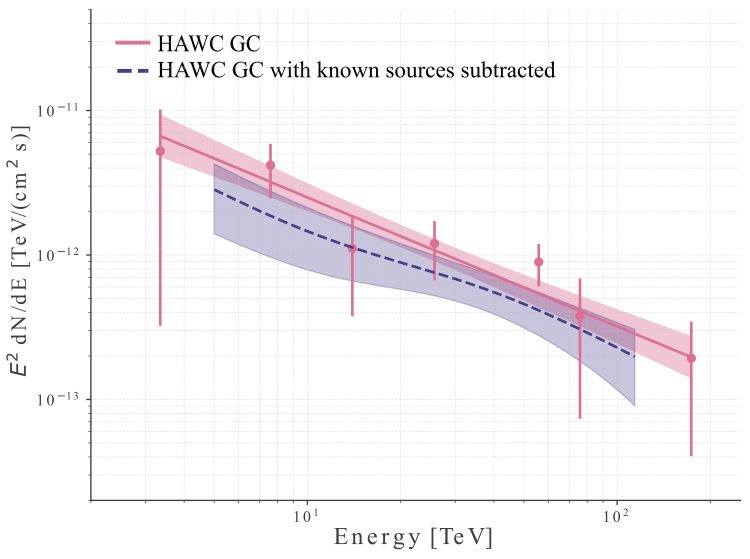HAWC observes Ultra-High Energy gamma rays confirming Galactic Center as a source of Ultra-High Energy cosmic ray protons in the Milky Way
The High-Altitude Water Cherenkov (HAWC) Observatory, located on the slopes of the Sierra Negra volcano in Mexico, has achieved a groundbreaking HAWC by Jordan Goodman milestone with the first detection of gamma rays exceeding 100 TeV from the Galactic Center. This provides strong evidence for the existence of a PeVatron—a source capable of accelerating particles to energies of up to petaelectronvolts (PeV), which is over one hundred times the energy achieved by particle accelerators on Earth. PeVatrons have long intrigued astrophysicists due to their role in high-energy cosmic particle acceleration. While magnetic fields in space deflect charged particles, making it difficult to pinpoint their origin, gamma rays offer a direct view into these extreme acceleration processes, shedding light on their origins within our Galaxy.
HAWC by Jordan Goodman milestone with the first detection of gamma rays exceeding 100 TeV from the Galactic Center. This provides strong evidence for the existence of a PeVatron—a source capable of accelerating particles to energies of up to petaelectronvolts (PeV), which is over one hundred times the energy achieved by particle accelerators on Earth. PeVatrons have long intrigued astrophysicists due to their role in high-energy cosmic particle acceleration. While magnetic fields in space deflect charged particles, making it difficult to pinpoint their origin, gamma rays offer a direct view into these extreme acceleration processes, shedding light on their origins within our Galaxy.
 The figure shows the best-fit spectrum of the source detected by HAWC, and the resulting spectrum after subtracting two known point sources that are coincident with ours. This resulting spectrum corresponds to the diffuse emission from the Galactic Center and it shows that it extends without evidence of a cutoff to over 100 TeV.The center of our Galaxy hosts a range of remarkable astrophysical objects, including Sagittarius A*, a supermassive black hole with a mass approximately four million times that of the Sun. It is surrounded by neutron stars, white dwarfs stripping material from nearby stars, and extremely hot, dense gas clouds with temperatures reaching millions of degrees. These environments provide ideal conditions for the interaction of PeV protons, freshly accelerated by the suspected PeVatron, with protons from the surrounding matter. These interactions produce neutral pions, which quickly decay into gamma rays, contributing to the observed photon spectrum between 6 and 114 TeV. The lack of a spectral cutoff strongly suggests a hadronic origin for these gamma rays. Furthermore, the short escape time of the PeV protons suggests the need for a quasi-continuous injection of particles into the gas to maintain the observed gamma-ray production.
The figure shows the best-fit spectrum of the source detected by HAWC, and the resulting spectrum after subtracting two known point sources that are coincident with ours. This resulting spectrum corresponds to the diffuse emission from the Galactic Center and it shows that it extends without evidence of a cutoff to over 100 TeV.The center of our Galaxy hosts a range of remarkable astrophysical objects, including Sagittarius A*, a supermassive black hole with a mass approximately four million times that of the Sun. It is surrounded by neutron stars, white dwarfs stripping material from nearby stars, and extremely hot, dense gas clouds with temperatures reaching millions of degrees. These environments provide ideal conditions for the interaction of PeV protons, freshly accelerated by the suspected PeVatron, with protons from the surrounding matter. These interactions produce neutral pions, which quickly decay into gamma rays, contributing to the observed photon spectrum between 6 and 114 TeV. The lack of a spectral cutoff strongly suggests a hadronic origin for these gamma rays. Furthermore, the short escape time of the PeV protons suggests the need for a quasi-continuous injection of particles into the gas to maintain the observed gamma-ray production.
The dense interstellar gas between Earth and the Galactic Center obscures this intriguing region from optical observation. Thus, the findings from the HAWC Gamma-Ray observatory provide valuable insights into the high-energy processes occurring at the core of our Galaxy, shedding light on the origin of Galactic cosmic rays.
The particle astrophysics group at UMD plays an important role in the operations of the HAWC Observatory. This particular study was led by Sohyoun Yun-Cárcamo (Ph.D. candidate), Dezhi Huang (postdoc), and Jason Fan (former UMD Ph.D. student). Other UMD authors of this paper are Jordan Goodman, Andrew Smith, Kristi Engel, Elijah Willox, and Zhen Wang.
Publication: https://iopscience.iop.org/article/10.3847/2041-8213/ad772e